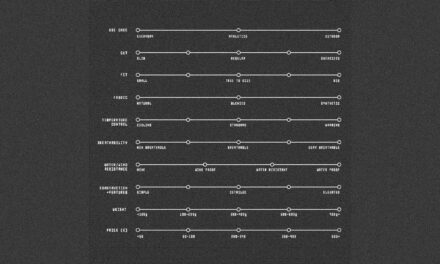On Performance and Pressure
Jana Strahler is a professor in sports psychology at the University of Freiburg, Germany. We met with her to talk about performance and pressure, mental strategies, the impact of social media and how to become a more mindful runner.
APR MAG: When was the last time you felt pressure?
Jana Strahler: Hmm, good question. At the moment, I’m working a lot and I have a lot of responsibility, which of course also brings expectations. Just last week, my colleague couldn’t make it to an important meeting. I was supposed to take over the moderation, and I really felt the pressure then. I always try to frame it directly. I see pressure as a sign that it matters to me, that it motivates me and gets me into the mood to perform.

APR MAG: Why do we even feel pressure, and how does it manifest in our bodies?
Jana Strahler: For me, the umbrella term here would rather be stress. I have spent a long time researching in the field of stress, and we make a distinction between acute and chronic stress. Stress occurs when we feel that the demands a situation places on us exceed our resources. That means when I experience demands, challenges, or a threat from the outside and assess my own resources as insufficient to handle the situation. From an evolutionary biology perspective, pressure is a form of stress that prepares our brain to respond efficiently and quickly. This shows up in our bodies at different levels. On one side, there is the hormonal stress axis, the hypothalamus-pituitary-adrenal axis. Our most important stress hormone, cortisol, is released under acute stress and mediates many reactions, such as the onset of gluconeogenesis in the liver, where sugar is made available for our muscles in short chains to enable fight or flight.
In the cardiovascular system, we see activation: increased heart rate, blood pressure. Again, the body is preparing for performance, transporting blood everywhere – to the muscles, the central nervous system, and the brain. Breathing becomes faster to provide more oxygen quickly. We sweat, where energy is being burned. Heat is generated, which needs to be released. We turn red. Some people get red in the décolletage, others in the area under the cheeks. This is a typical stress reaction. Some people notice it in their digestion. Normally, digestion is supposed to be inhibited, but many experience nausea or gastrointestinal issues in an acute pressure situation as a typical response. In addition to the physical reactions, we also have emotional and cognitive reactions. We experience a focus – we can imagine this as blinders. Emotional reactions include fear, apprehension, or a feeling of being overwhelmed, but also motivation. Our reaction is therefore very adaptive. Without this pressure or stress situation, we wouldn’t be here today. We wouldn’t have been able to flee from lions. Fight or Flight is a well-known term.
APR MAG: In what situations do we usually experience pressure?
Jana Strahler: The history of stress models is quite old. Hans Selye was one of the first to study stress using animal models, with rats and mice. His thesis was that the stress response is something uniform. However, this was quickly supplemented because it looks different in humans. Not every stressor leads to the same reaction; the situations are decisive. The same situation can be experienced differently by different people, and even by the same person at different times. A small example: Let’s assume I’m stuck in traffic. If I have an important appointment, I sit behind the wheel, clutch the steering wheel tightly, and wait impatiently for the traffic to move. However, if I have plenty of time, being stuck in traffic can be totally fine. It’s the same situation, but I react differently.
In the 1970s, attempts were made to identify situational characteristics that are more likely to lead to stress for many people. For example, novelty or uncontrollability. If I’ve never experienced a situation before, I don’t know how to handle it, and that triggers stress. In a job interview, for example, it’s the person on the other side of the table. Power, stress, unpredictability, ambiguity, and ego involvement are important here. I’m in a situation where I want to perform well. In typical stress situations, I have to exert myself to reach my goal, but still have little control over the outcome.

APR MAG: Are there certain characteristics or biological parameters that make us more or less susceptible to stress?
Jana Strahler: It seems to be a mix of personality traits and experience. Mental strategies are also important here. Broadly speaking, these characteristics can be divided into four areas. At the top is neuroticism. These are people who are particularly emotionally sensitive and tend to experience more anxiety or self-doubt, which in turn amplifies pressure. The second trait is perfectionism, extremely high expectations of oneself. Mistakes are quickly perceived as personal failure, and one internalizes setbacks more easily. The third characteristic is low self-efficacy. If I don’t believe in my own abilities, I’m more likely to feel overwhelmed and stressed. The fourth trait is socialization. If I grew up in an environment where there was a lot of pressure to perform, that can make me particularly susceptible to stress because I’m more sensitized to such situations.
Experience and successes are also important. When I succeed, it brings self-confidence. If I have experienced that I can handle difficult situations, it gives me self-assurance.
As for biological factors, there is an entire research branch that deals with the biological and neurobiological factors of stress resistance and resilience. There is evidence that cortisol, as well as adrenaline and noradrenaline, might be regulated differently in different people. This would mean that some people react more quickly or strongly to stress, while others have a more optimal stress response and recover faster. There is some initial evidence that it could also be genetic, related to our reward system.
Regarding mental strategies, the key term is certainly realistic optimism. Accepting that it is a challenge that won’t be easy, but that I have the capabilities to succeed. Being able to try things out and do things, rather than just having to.
APR MAG: Let’s move on to the topic of sports, or more specifically, running. What can trigger pressure or stress in this context?
Jana Strahler: First, there are competition-related stressors, such as performance pressure before important races. How strong are the other participants? How good is my form? Do I have a technical issue that I can’t solve? Was I recently injured? That would be competition-related pressure. The second distinction is training-related problems. Can I train the way I want to? Can I train at the location I want? Are there interpersonal conflicts in my team? Even though running is considered an individual sport, it can also be a team sport. Are there perhaps organizational issues? How is my lifestyle outside of running? Financial problems are certainly an aspect, especially in sports that are not embedded in specific structures. The three aspects that create pressure in sports are therefore mental, physical, and social.


APR MAG: This sounds very performance-oriented. But what about people for whom running is a hobby? How does performance sport differ from amateur sport?
Jana Strahler: For ambitious runners, the pressure is more existential. Performance expectations, public evaluation – these are topics that are more relevant in elite sports. In amateur sports, those are self-set goals. The external pressure is lower. We hardly have any public attention, less social evaluation. Injury pressure, competition pressure within the regional environment, or competition with oneself also exist in amateur sports. This is certainly frustrating in amateur sports, but not necessarily associated with existential consequences. We see big differences between elite sports and amateur sports. Elite athletes today almost can’t avoid targeted mental training.
Physiological aspects in elite sports lead to better handling of pressure because they are used to it. This is different in amateur sports. There are fewer experiences with high-pressure situations, and there is less social support. In elite sports, there are coaches and psychologists, in amateur sports, we have friends, family, and maybe a coach. Elite athletes are more used to pressure, but for them, it is existential. Even in amateur sports, there is pressure, but here it is more perceived as personal failure.
APR MAG: Currently, we are seeing an extreme running boom. There are countless running apps, participation numbers in races are enormous, and people share their runs on social media. This also leads to comparisons, which can quickly trigger pressure or stress. What impact do social media have on our experience of pressure?
Jana Strahler: The pressure of comparison is certainly an aspect that social media has triggered through data tracking. Every training session is measurable and comparable. Hobby athletes suddenly see themselves on a virtual leaderboard. This can trigger pressure to run faster or longer. A red flag for me as a sports psychologist is statements like: “If I haven’t tracked it, it doesn’t count.” The fact that some athletes feel obligated to share their training can lead to them continuing to train despite fatigue or injury, just to look good. One has to be very careful about that. A big point is also that competitive training is taking precedence over the enjoyment of the sport. What started as fun – segment times and likes – becomes a competition. This can lead to the situation where I can no longer just go for a jog because a friend of mine was faster, and now I feel like I have to push myself harder.
In social media, there’s also the issue of public evaluation and expectation pressure. We see how others train, which records they break, how fit they look or are, and how they present themselves. We compare ourselves to that, and it can amplify self-doubt. Now it’s no longer just about performing in sports, but about making life appear perfect. This can lead to perfectionism, which we’ve already discussed as potentially contributing to stress. Media literacy is definitely required here. Of course, only the best is shown: maximum performance, personal bests, well-toned bodies. This reinforces the feeling that I can never achieve that, which in turn can intensify the pressure.
However, social media also have the positive aspect that they can get people into movement, making the entry point more accessible. One can achieve training success relatively quickly. That is definitely a pro argument. When it comes to pressure and comparison, we just need to be more cautious.
APR MAG: What contribution can running brands make through marketing campaigns to reduce the pressure that runners feel, in order to promote a more liberated approach to running?
Jana Strahler: What I like to discuss with my athletes is: Why do you actually run? Do you run for yourself or for others? Do you have performance goals? Are they goals for enjoyment? These are questions we can all ask ourselves. What goals do I have? Are they quantitative goals – do I want to set a new personal best? Are they qualitative goals? I want to feel fresher after the run, feel fitter, I want to feel exhausted, feel like I’ve accomplished something – reframing. As runners, we tend to feel slower times are bad, because progress for many means running longer and faster. But I can also consciously choose the slower run. This change of perspective is important.

APR MAG: So it’s also about how things are presented, with very athletic body images for example, or with a photo showing a runner crossing the finish line first?
Jana Strahler: Yes. Quantitative goals like crossing the finish line first are relatively easy to present. But how do we present qualitative goals? I think it fits with what I just said about the change of perspective. Becoming clear about why I run. Consciously engaging with performance parameters and social media. Not tracking and posting every run, but also consciously taking offline running times. Running without a watch, just going by feel. We also want to get back to our body feeling. If I offload that every time into an app, I lose that feeling. One should also use that as a training moment, without wearables.
APR MAG: So, as an example: if I want to run seven kilometers easily, I should leave the watch at home, and run a route that I know is about seven kilometers, and just jog.
Jana Strahler: Yes, mindfulness is important here – mindful running. Instead of thinking in terms of pace and distance, being in the here and now, not looking at the watch, even if it’s running with me. Paying attention to how the ground feels under my feet. How my breathing is. What’s the weather like? How does the environment affect me? Do I find it pleasant? How do the shoes fit? How does my clothing fit? Focusing on the running “I.” Acceptance instead of perfectionism, even in more difficult phases. Bad days are completely normal. Failure is part of the development process, we can learn from failure. Accepting that and asking: What have I learned from this? Maybe it’s the nutrition. You can work on that, keyword self-talk. We all have negative thoughts, but then trying to make something positive out of them. For example, the thought: “I’m so slow today.” A reframing here would be: I’m doing something good for my body, no matter the speed. Instead of thinking, “I have to run,” think, “I get to run.” It’s about my identity as a runner, uncoupling performance from identity. My performance doesn’t define who I am as a person or whether I’m allowed to be liked. Enjoyment runs are important. It’s not about performance, it’s about movement and health. Sometimes I might need to run with super fast friends because I need extra motivation. But in the end, it’s about finding people who share my mentality, who run for similar reasons as I do. Maybe I also prefer running alone, to define success for myself. But that doesn’t have to mean a new personal best.
APR MAG: I’d like to go back to the point of mindful running. Is there a protocol or a specific method to get into this mode?
Jana Strahler: A body scan would be a good keyword here. So starting at a specific body region, for example, the feet, and then going through each body part. How does it feel right now? How do my feet hit the ground? How do my joints feel? Is everything running smoothly? Does it grind somewhere? A classic body scan.
APR MAG: And what do I do if I don’t feel good?
Jana Strahler: What we train in mindfulness is to accept that as a fact, and tell ourselves that it’s okay as it is. That it’s an expression of body awareness, and then continue as best as possible. Later, you can come back to it and check if it’s still the same. This acceptance is part of it and doesn’t mean something is wrong; it’s just a state for now.
APR MAG: Okay, so identifying the state without qualitative judgment. Describing, acknowledging, and moving on.
Jana Strahler: Exactly. Letting go.

APR MAG: We’ve talked a lot about performance pressure. What is the actual goal in hobby sports? Even though this can be very individual, what should the actual motivation and goal be?
Jana Strahler: Again, a really exciting, multifaceted question, and in a way, you’ve already given the answer yourself – it’s individual. We should focus on individual factors and goals, on the intrinsic. On goals that come from within, rather than external pressures like comparing ourselves to others. Sports should primarily serve health and well-being. We know this. Many studies show that regular physical activity reduces stress, strengthens the immune system, improves mental abilities, and enhances psychological resilience. It’s not about achieving maximum performance, but about staying fit and mobile in the long term. Imagining what’s still possible when we’re older because we’ve taken care of ourselves now and haven’t overstrained our bodies. Sports should bring joy. This means we don’t experience it as an obligation, but as fun and enrichment. Sports can also bring people together; it happens as a shared experience. Personal development is also important here. Not focusing on the time, but on how I can personally develop. It’s not about being better than others, but about how I can improve my own performance in a healthy way, for a good body feeling. To practice sports in an individual, intrinsic, and sustainable way, we need to talk about goal setting and clarifying needs. Why am I doing this? Is it about feeling better? Integrating movement into daily life? Getting joy from the activity? Do I want to compare myself with others? Do I want to connect with others? This community behind it can also motivate and support. An important question is always: Would you still do this sport if no one was watching? If you answer yes to that, then you’re intrinsically motivated to do this sport. And that’s exactly what we want. Then you’ve found the right focus and the right sport.
APR MAG: The social aspect of running is almost indispensable nowadays. What role do running communities play, and how can they influence the reduction of performance pressure?
Jana Strahler: I completely agree, communities are playing an increasingly larger role. The social aspect of sports is really important. When we want to get back into it after a long break from exercise, it’s incredibly helpful to have someone who joins you. Emotional support. What we need is a guideline – what forms of success are made visible and appreciated? Should it really be personal bests, or is it about sharing positive stories? Someone ran pain-free for the first time in weeks, someone ran without a watch and loved it. Moving from quantitative to qualitative goal criteria. A community that lives this, that has a positive feedback culture, can massively support this. Is only the fastest person praised, or do I also praise progress regardless of what number is shown?
If the communal experience is truly the focus, and not performance. Maybe we can also establish alternative success experiences. Instead of celebrating pace, maybe we can also represent and praise these softer successes? These are some ideas I would have in this context.
APR MAG: Thank you very much.
Picture of Prof. Dr. Jana Strahler by Silvia Wolf
Other pictures: On





